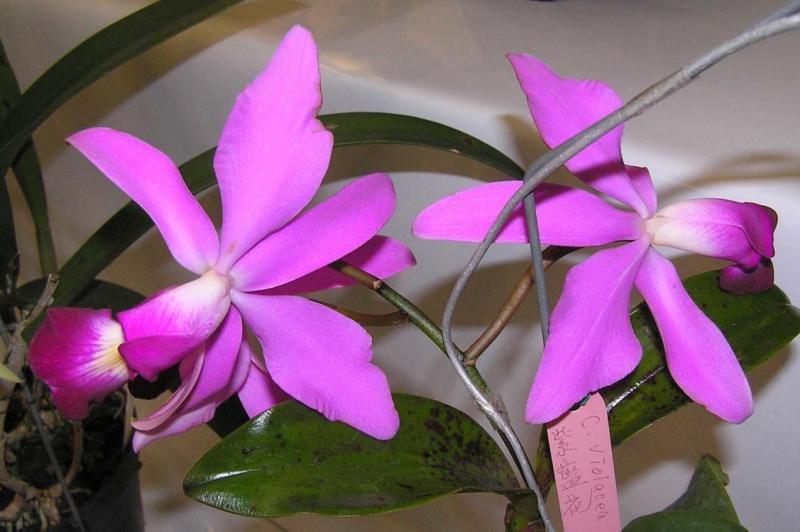Cattleya violacea
Also known as: Superba Of The Orinoco or Cattleya violacea h.f. flammea-semialba Cattleya violacea h.f. coerulea Cattleya violacea h.f. suavissima Cattleya violacea h.f. albescens Cattleya violacea h.f. semialba-striata Cattleya violacea h.f. striata Cattleya violacea h.f. aquinii-semialba Cattleya violacea h.f. flammea Cattleya violacea h.f. rubra-venosa Cattleya violacea h.f. violacea Cattleya violacea h.f. carnea Cattleya violacea h.f. semialba Cattleya violacea h.f. delicata Cattleya violacea h.f. aquinii Cattleya violacea h.f. vinicolor Cattleya violacea h.f. delicata-semialba Cattleya violacea h.f. rubra Cattleya violacea h.f. flammea-striata Cattleya odoratissima Cattleya schomburgkii Epidendrum superbum Cymbidium violaceum Cattleya violacea var. alba Cattleya violacea var. splendens Cattleya violacea h.v. superba Cattleya violacea var. ashworthii Cattleya superba var. wellsiana Cattleya superba var. alba Cattleya superba var. splendens Cattleya superba var. ashworthii Cattleya violacea f. alba Cattleya violacea var. huebneri Cattleya violacea var. wellsiana Cattleya superba in the subfamily: Epidendroideae
Native to: Departamento del Huila - Colombia Departamento del Meta - Colombia Guyana Sao Paulo - Brazil
General Information
Superba Of The Orinoco is a large sympodial cool to hot growing epiphytic or terrestrial orchid belonging to the sub family Epidendroideae native to Colombia, Guyana and Brazil.
Plant Description
Sympodial. Grows to 10-20cm. Each new growth has numerous elliptic leaves that grow to 4-16cm long. Pseudobulbs grow to 0.5-20cm
Flowers
Numerous long lasting, fragrant blossoms appear during Summer
Fragrance
The orchid is fragrant.
Blooming Season
- Summer
Substrate(s)
- Coarse
- Medium
- Bark
Care Notes
This orchid goes into a dormancy phase during winter, during this phase it is best not to provide water unless the plant is starting to look thirsty. The lack of water increases the chance of flowering in spring, and also reduces the likelihood of any rot forming. Do not resume watering until new growth has appeared and is growing strongly.
Often a period of intense growth occurs after dormancy. During this time the amount of light, water and fertiliser the plant receives will directly impact the amount of growth that occurs during this time, and in the case of seedlings, will reduce the time required to reach maturity.
It's recommended to heavily reduce the water amount at the middle to end of autumn to trigger dormancy. Leaves on older bulbs will begin to drop during this time while the newer bulbs continue to mature until terminal leaves appear at the tip of the pseudobulbs.
Repotting can be done any time of the year though it's best to do it in early spring when new growth is appearing as this also means new roots will appear to help the plant anchor into the new media and offset any damage to established roots during the repotting process.
Fragrant:
- IsFragrant
Climate
Grows at low to high elevations. Rainfall ranges from 38mm to 262mm per day, heaviest in September and lightest in February. Humidity ranges from 70% to 81%, highest in October and lowest in March. Temperature ranges from 21C to 31C, highest in March (22C to 31C) and lowest in January (21C to 28C).
Watering
Keep moisture levels up during hot weather as the plant is prone to dehydration
Fertiliser
dormant-medium-demand-orchid Be sure to flush out excess fertiliser by running water through the media regularly year round. Apply fertiliser regularly at half strength year round. Use a high Nitrogen fertiliser during Spring and Summer. Use a high Phosphorous fertiliser during Summer.
Potting
These plants can be sensitive to repotting though should not require repotting regularly. Repotting should be done when the mix has broken down to the point that it doesn't absorb water or holds onto water for far too long, usually the plant shows a decline in growth as well. Repotting is best done after the growing season when the plant has died back.
The mix should be free draining, with a blend of 30% inorganic ingredients such as coarse sand, gravel or perlite, mixed in with about 70% organic ingredients such as peat, leaf litter or decomposed bark. Avoid commercial potting mixes as they can vary wildly and may contain "wetting agents" that can hold onto water for loo long, causing rotting and stunted growth.
This plant does well mounted. Repotting is best done annually.





















